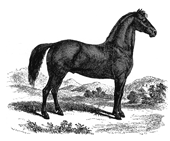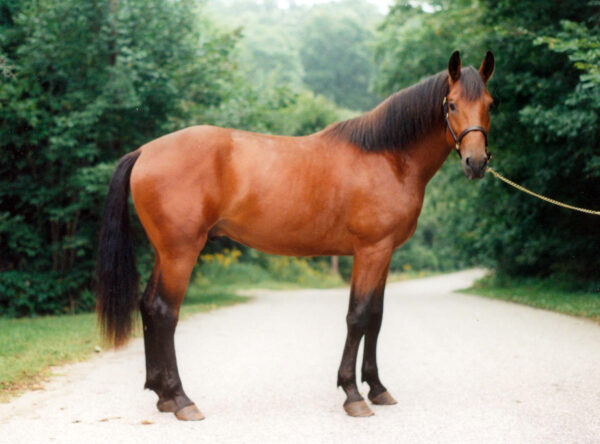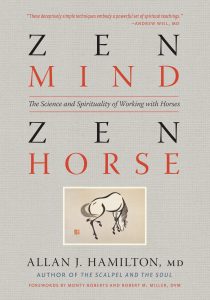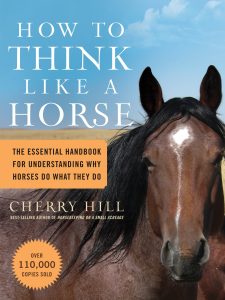
Breed Facts
Status:
Critical
Use:
Sport riding, Driving
Adult Weight:
1200-1500 lbs.
Adult Height:
16-17 hands
Temperament:
Docile, sensible
Experience Level:
Novice – Intermediate
Notes:
Always bay in color; intelligent; gentle; crosses make excellent sport horses; easy to train
CLEVELAND BAY
The Cleveland Bay was developed in Yorkshire, England. The ancestors are believed to be the now-extinct “Chapman Horse” that was bred and used in the Yorkshire Dales as pack horses by the traveling salesmen (‘chapmen”) of the age. The preferred color for these horses was bay. Barb horses brought to the port of Whitby in the 1600-1700s (that were also used in the creation of Thoroughbreds) were crossed with the Chapman horses to produce an early type of Cleveland Bay. These horses were selected for strength, speed, soundness, and stamina – the qualities needed for performance in long-distance transport, farm work, and riding over rough terrain. (Recent genetic research shows possible links between the Cleveland Bay and the Turkomen horses behind the Akhal-Teke breed.)
The Cleveland Bay existed in its modern form by 1800, with the breed name “Cleveland” referring to the Vale of Cleveland in Yorkshire, and “Bay” to its reddish-brown color with black points. The Cleveland Bay Horse Society was formed in Britain in 1884.
Cleveland Bay horses were first imported to the United States in the early 1800s. Colonel Richard Henry Dulaney of Virginia was so proud of his horses that he began the Upperville Colt & Horse show in 1884 to showcase them. (This show is held annually and has a class specifically for Cleveland Bay horses.) The Cleveland Bay Society of America was founded in 1885 and an American stud book was established; over 2,000 horses were registered by 1907. Buffalo Bill Cody was among those interested in the breed, and he drove a hitch of four Cleveland Bay stallions in his Wild West Show. The breed became rare in the 1900s when mechanization eliminated the demand for farm, coach, and riding horses for travel.
Over two hundred years of pure breeding resulted in a horse breed that is genetically consistent. This distinguishes it from other medium-weight horse breeds (Warmbloods) that have had extensive, recent introductions of Thoroughbred blood. The breed’s genetic distance from the Thoroughbred gives it excellent hybrid vigor in a cross, and Cleveland Bay stallions are often bred to Thoroughbred mares to produce “Sport Horses” – a horse with the best qualities of both breeds. The growing market for sport horses has been of little help because the lighter and faster Cleveland Bay crossbreds had more value than the purebreds, so rather than breed pure Cleveland Bays, breeders crossbred their mares.
The decline of pure breeding nearly caused the breed to become extinct; by 1960, there were only six living purebred Cleveland Bay stallions. The Cleveland Bay Horse Society of North America had become dormant but was revived in 1985, and the numbers of horses and breeders are increasing.
The British royal family and a few other breeders took the initiative to conserve the breed in the UK, it’s country of origin, and today there are perhaps as many as 1,000 Cleveland Bay horses alive worldwide, with about 220 purebreds in North America.
Cleveland Bays are always bay with black points, mane and tail, and no white markings except an occasional small star. They stand 16-17 hands (64-68″) at the withers and weigh 1,200-1,500 lbs. They have well-muscled hindquarters, sloping shoulders, and dense bone. The breed is known for its sound, durable feet and calm disposition. The Cleveland Bay gives an overall impression of dignity and strength. They are docile and sensible and tend to be easy to train.
This seriously endangered breed is in need of new stewards who are interested in breeding purebred Cleveland Bays.
Did you know:
The Dominique chicken is America’s oldest chicken breed and was widely raised on farms in the 1800s. Did your grandparents raise “Dominikkers”? Learn more about this beautiful but threatened breed at Dominique chicken – The Livestock Conservancy

Breed Facts
Status:
Critical
Use:
Sport riding, Driving
Adult Weight:
1200-1500 lbs
Temperament:
Docile
Experience Level:
Novice – Intermediate
Notes:
Always bay in color, intelligent, gentle, crosses make excellent sport horses
You may be interested in…
Managing Breeds for a Secure Future
By Dr. Phil Sponenberg, Dr. Alison Martin, Jeannette Beranger
$34.95
Manual of Methods for Preservation of Valuable Equine Genetics
By Kindra Rader, Charles C. Love, Charlene R. Couch and Katrin Hinrichs
$19.95






